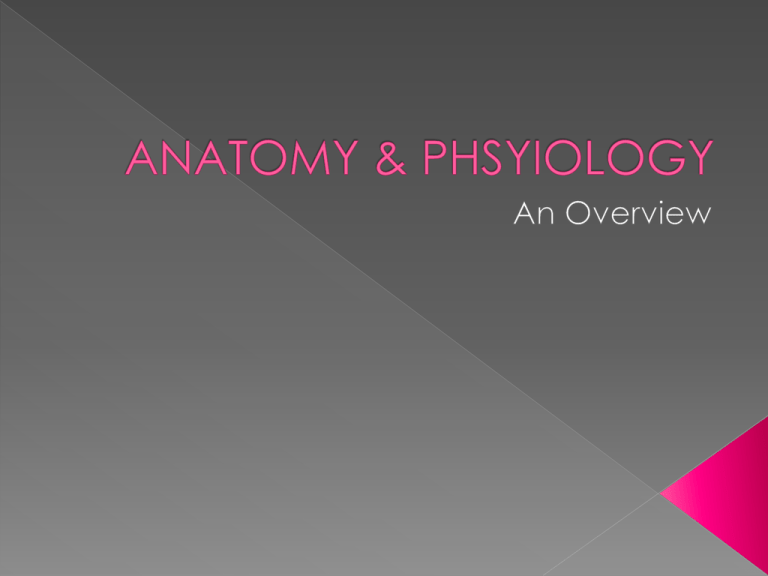ANATOMY & PHSYIOLOGY
advertisement

Is the study of the structure and shape of the body and body parts and their relationship to one another. › Gross anatomy: the study of large parts of the body › Microscopic anatomy: the study of microscopic parts Is the study of how the body and its parts work or function › Neurophysiology: The study of the workings of the nervous system › Cardiac physiology: The study of the function of the heart Anatomy and Physiology are always related Structure determines which functions can take place The body exhibits many levels of organization › Chemical level – atoms combine to form molecules › Cellular Level – molecules combine to make organelles which form cells › Tissues – consists of cells that have a common function › Organs- structure composed of 2 or more tissue types that perform a specific function › Organ Systems- a group of organs that cooperate to accomplish a common purpose › Organism – 11 body systems make-up the living body Smooth muscle cell Smooth muscle tissue 2. Cellular level Cells are made up of molecules 3. Tissue Level Tissue consists of similar types of cells 1. Chemical Level Atoms combine to form molecules Circulatory System Blood vessels 6. Organismal level Human organisms are made up of many organ systems 4. Organ Level Organs are made up of different types of tissue 5. Organ System Level Organ Systems consist of different organs that work closely together 11 body systems › Respiratory › Nervous › Urinary/Excretory › Endocrine › Digestive › Reproductive › Integumentary › Skeletal › Circulatory › Muscular › Immune FUNCTION STRUCTURE External covering of the body, skin Waterproofs the body Cushions and protects the deeper tissues from injury Prevents internal organs from drying out Regulates body temperature Temperature, pressure, pain receptors are located in the skin FUNCTION STRUCTURE Consists of bones, cartilage, ligaments, and joints Supports the body and provides a framework for skeletal muscles Provides protection for organs Formation of blood cells Storehouse for minerals STRUCTURE FUNCTION Contraction Movement STRUCTURE FUNCTION Fast-acting control center Consists of the brain, spinal cord, nerves, and sensory receptors STRUCTURE FUNCTION Controls body activities Endocrine glands produce hormones which regulate other structures in the body FUNCTION STRUCTURE Composed of the heart and blood vessels Carries oxygen, nutrients, hormones, and other substances to and from the tissue cells where exchanges are made White blood cells help protect the body against toxins The heart acts as the blood pump FUNCTION STRUCTURE Includes the lymphatic organs, lymph nodes, spleen, and tonsils Returns leaked fluid from the blood to the blood vessels so that blood can be continuously circulating through the body Helps to cleanse the body and house the cells involved in immunity STRUCTURE FUNCTION Keeps the body constantly supplied with oxygen and to remove the carbon dioxide Consists of the nasal passages, pharynx, larynx, trachea, bronchi, and lungs A long tube that runs from the oral cavity to the anus Includes the oral cavity, esophagus, stomach, small & large intestines, and rectum Breaks down food and delivers the products to the blood for dispersal to the body cells Ingestible foodstuffs are eliminated as feces STRUCTURE FUNCTION Rids the body of nitrogen containing waste (urea and uric acid) in the form of urine Maintains the body’s water and salt balance Regulates the acid-base balance of the blood Composed of the kidneys, ureters, bladder, and urethra STRUCTURE FUNCTION Exists primarily to produce offspring Male: STRUCTURE FUNCTION › Testes produces sperm and male sex hormone (testosterone) › Includes the scrotum, penis, glands and duct system Female: › Ovary produces eggs; or ova and female sex hormones (estrogen) › Includes the uterine tubes, uterus, and vagina › The uterus provides the site for the development of the fetus once fertilization has occurred › Mammary glands in the breast produce milk for newborns 1. 2. 3. Interdependency Necessary Life Functions Survival Needs Organ Systems do not work alone › The integumentary system protects the body as a whole from the external environment › The digestive and respiratory system , in connection with the external environment, take in nutrients and oxygen › Nutrients and oxygen are distributed by the blood to all body cells › Elimination of metabolic wastes from the body is accomplished by the urinary and respiratory system Maintain Boundaries Movement Respond to Environmental Change Take in and digest nutrients Carry out metabolism Dispose of waste Reproduce Grow An organism’s insides must remain distinct from its outsides Every cell in the human body is surrounded by a membrane that contains its contents and restricts the entry of potentially damaging or unnecessary substances The whole body is enclosed by the integumentary system Includes all the activities promoted by the muscular system The muscular system is aided by the skeletal system Also occurs when substances such as blood, food stuffs, and urine are propelled through the internal organs of the cardiovascular, digestive and urinary system. The ability to sense changes (stimuli) in the environment and then to react to it. The nervous system bears the majority of the responsibility because they fire electrical impulses quickly between each other Process of breaking down and absorbing food into simple molecules that can be absorbed into the blood for delivery to all body cells by the cardiovascular system All chemical reactions that occur within the body cells › Breaks down complex substances into simpler building blocks › Makes larger structures from smaller ones › Using nutrients and oxygen to produce ATP molecules ATP – energy rich molecules that powers cellular activities Depends on › Digestive and respiratory systems to make nutrients and oxygen available to the blood › Circulatory system to distribute these substances throughout the body Regulated chiefly by hormones secreted by the glands of the endocrine system Process of removing excreta (waste) from the body The body must get rid of nonuseful substances produced during metabolism and digestion. The production of offspring Can occur at the cellular or organismal level Cellular › Mitosis – somatic cells › Meiosis – gametes The function of the reproductive system is regulated by hormones of the endocrine system An increase in size An increase in the number of cells Cell-constructing activities must occur at a faster rate than cell-destroying activities The goal of all body systems is to maintain life Includes: › Nutrients › Oxygen › Water › Temperature › Atmospheric Pressure NUTRIENTS Approximately 20% of the air we breathe is pure oxygen It is made available to cells in body through the circulatory and respiratory systems OXYGEN Taken in via your diet Contain chemicals used for energy and cell building Carbohydrates are the major energy producing fuel Proteins and fats (lipids) are essential for building cell structures Fats cushion body organs and provide reserve fuel Minerals and vitamins are required for the chemical reactions that go in cells and for oxygen transports in the blood. 60-80% of body weight The single most abundant chemical substance in the body Provides the fluid base for body secretions and excretions Obtained solely from ingested foods and liquids Lost by evaporation from the lungs and skin and in body excretions WATER Body temperature must be maintained at around 37oC (98oF) If body temperature drops below normal range, metabolic reactions become slower and finally stop If body temperature is too high, chemical reactions proceed too fast, and body proteins begin to break down, causing death. TEMPERATURE AMTOSPHERIC PRESSURE The force exerted on the surface of the body by the weight of air Controls breathing and the rate of Carbon dioxide exchange High altitudes where air is thin and atmospheric pressure is lower, gas exchange may be too slow to support cellular metabolism. The body’s ability to maintain relatively stable internal conditions, even though the outside world is changing Indicates a dynamic state of equilibrium › EX. Blood levels/ blood pressure Excretion of waste Body temperature Communication is IMPORTANT Accomplished chiefly by the endocrine and nervous systems All homeostatic control mechanisms have 3 parts › Receptor › Control center › Effector Some type of sensor that monitors and responds to changes in the environment Responds to changes called stimuli by sending information (input) to the control center along the afferent pathway Receptor › Afferent means to approach/ go towards the Control Center control center Determines the levels (set point) at which a variable is to be maintained Analyzes the information it receives Determines the appropriate response or course of action Effector Provides the means for the control center’s response (output) to the stimulus Information flows from the control center to the effector along the efferent highway › Efferent information exits the control center The results of the response then feed back to the influence the stimulus › Depressing it – negative feed back › Enhancing it – positive feed back Interaction between the receptor, control center and effector is necessary for normal operation of the system Negative › Home heating systems › Hypothalamus by regulating heart rate, blood pressure, breathing rate, blood levels of C6H12O6, O2, CO2, and minerals Positive The net effect of the response is to the stimulus is to shut off the original stimulus or to reduce its intensity Rare in the body Increase the original disturbance (stimulus) and push the variable further from its original value. › Blood clotting › Birth of a baby Cause some diseases Internal conditions become less and less efficient Cause a greater risk for illness and produce changes in the body








